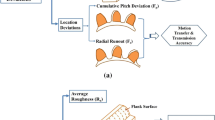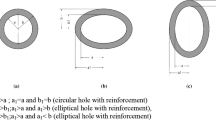Abstract
This paper deals with the extrusion of gear-like profiles and uses of finite element method (FEM) and artificial neural network (ANN) to predict the extrusion load. In the study, gear-like components has been manufactured by forward extrusion for the AA1070 aluminum alloy and the process was simulated by using a DEFORM-3D software package to establish a database in order to provide the data for ANN modeling. Serious experiments were performed for only one die set and four teeth gear profile to obtain data for comparing with DEFORM-3D results. After verifying a highly appropriate FEM simulation with the experiment at the same conditions, Results were enhanced for different die lengths, extrusion ratios, and two extra teeth number as three and six using FEM simulations. Subsequently, the data from the performed FEM simulations were submitted for the best obtained ANN model. Finally, a good agreement between FE-simulated and ANN-predicted results was obtained. The proposed ANN model is found to be useful in predicting the forming load of the different die set variations based on the reliable test data.
Similar content being viewed by others
References
Azad-Noorani M, Bakhshi-Jooybari M, Hosseinipour SJ, Gorji A (2005) Experimental and numerical study of optimal die profile in cold forward rod extrusion of aluminum. J Mater Process Technol 164–165:1572–1577
Bakhshi-Jooybari M, Saboori M, Noorani-Azad M, Hosseinipour SJ (2007) Combined upper bound and slab method, finite element and experimental study of optimal die profile in extrusion. Mater Des 28:1812–1818
Maity KP, Kar PK, Das NS (1996) A class of upper-bound solutions for the extrusion of square shapes from square billets. J Mater Process Technol 62(1–3):185–190
Chen DC, Syu SK, Wu CH, Lin SK (2007) Investigation into cold extrusion of aluminum billets using three-dimensional finite element method. J Mater Process Technol 192–193:188–193
Chen CT, Ling FF (1968) Upper-bound solutions to axisymmetric extrusion problems. Int J Mech Sci 10(11):863–879
Reggiani B, Segatori A, Donati L (2013) Prediction of charge welds in hollow profiles extrusion by FEM simulations and experimental validation. Int J Adv Manuf Technol 69:1855–1872
Fereshteh-Samiee F, Karimi M, Sabzalipor M (2009) An investigation on the effect of process variables on the required load in axisymetric forward rod extrusion. 3rd international conference on integrity, reliability and failure, Porto
Karami P, Abrinia K (2014) An analytical formulation as an alternative to FEM software giving strain and stres distributions for the three-dimensional solution of extrusion problems. Int J Adv Manuf Technol 71:653–665
Onuh SO, Ekoja M, Adeyemi MB (2003) Effects of die geometry and extrusion speed on the cold extrusion of aluminium and lead alloys. J Mater Process Technol 133:274–285
Qamar SZ, Arif AFM, Sheikh AK (2004) A new definition of shape complexity for metal extrusion. J Mater Process Technol 155–156:1734–1739
Zhang C, Zhao G, Chen H, Guan Y, Li H (2012) Optimization of an aluminum profile extrusion process based on Taguchi’s method with S/N. Int J Adv Manuf Technol 60(5-8):589–599
Jung SY, Kang MC, Kim C, Kim CH, Chang YJ, Han SM (2009) A study on the extrusion by a two-step process for manufacturing helical gear. Int J Adv Manuf Technol 41:684–693
Song JH, Im YT (2004) Development of a computer aided-design system of cold forward extrusion of a spur gear. J Mater Process Technol 153–154:821–828
Altinbalik T, Ayer Ö (2013) Effect of die inlet geometry on extrusion of clover sections through curved dies: upper bound analysis and experimental verification. Trans Nonferrous Metals Soc China 23(4):1098–1107
Altinbalik T, Ayer Ö (2008) A theoretical and experimental study for forward extrusion of clover sections. Mater Des 29(6):1182–1189
Toros S, Ozturk F (2011) Flow curve prediction of Al–Mg alloys under warm forming conditions at various strain rates by ANN. Appl Soft Comput 11:1891–1898
Mandal S, Sivaprasad VP, Venugopal S, Murthy NPK (2009) Artificial neural network modeling to evaluate and predict the deformation behavior of stain less steel type AISI 304 L during hot torsion. Appl Soft Comput 9:237–244
Sheikh H, Serajzadeh S (2008) Estimation of flow stress behavior of AA5083 using artificial neural networks with regard to dynamic strain ageing effect. J Mater Process Technol 196:115–119
Hsiang SH, Lin YW (2008) Application of fuzzy theory to predict deformation behaviors of magnesium alloy sheets under hot extrusion. J Mater Process Technol 201(1–3):138–144
Hagan MT, Demuth HB, Beale MH (1996) Neural network design. PWS Publishing, Boston
Patterson DW (1995) Artificial neural network theory and application. Prentice Hall
Patterson JM (1997) Introduction to artificial neural systems, 2nd edn. Jaico Publishing House, New Delhi
Haykin SS (1999) Neural networks: a comprehensive foundation. Upper Saddle River, Prentice Hall
Li YY, Bridgwater J (2000) Prediction of extrusion pressure using an artificial neural network. Powder Technol 108:65–73
Hsiang SH, Kuo JL, Yang FY (2006) Using artificial neural networks to investigate the influence of temperature on hot extrusion of AZ61 magnesium alloy. J Intell Manuf 17:191–201
Qin YJ, Pan QL, He YB, Li WB, Liu XY, Fan X (2010) Artificial neural network modeling to evaluate and predict the deformation behavior of ZK60 magnesium alloy during hot compression. Mater Manuf Process 25(7):539–545
Zhou J, Li L, Mo J, Zhou J, Duszczyk J (2009) Prediction of the extrusion load and exit temperature using artificial neural networks based on FEM simulation. Key Eng Mater 424:241–248
Jawwad AKA, Barghash MA (2013) Evaluating the effects of process parameters on maximum extrusion pressure using a new artificial neural network (ANN-based) partial-modeling technique. Int J Adv Manuf Technol 68(9-12):2547–2564
Freeman JA, Skupura DM (1991) Neural networks algorithms, applications and programming techniques. Addison-Wesley, Reading
Ayer Ö (2012) Düz Dişlilerin İmalat Yöntemi Optimizasyonu ve Analizler. Ph.D. Thesis, Institute of natural sciences, Trakya University
Author information
Authors and Affiliations
Corresponding author
Rights and permissions
About this article
Cite this article
Bingöl, S., Ayer, Ö. & Altinbalik, T. Extrusion load prediction of gear-like profile for different die geometries using ANN and FEM with experimental verification. Int J Adv Manuf Technol 76, 983–992 (2015). https://doi.org/10.1007/s00170-014-6328-z
Received:
Accepted:
Published:
Issue Date:
DOI: https://doi.org/10.1007/s00170-014-6328-z




